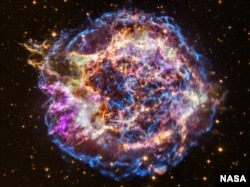The European Southern Observatory on Monday released an image of colorful clouds of gas created by the explosion of a huge star long ago.
The clouds are in our own Milky Way galaxy about 800 light years from Earth. A light year is the distance light travels in a year, 9.5 trillion kilometers. Scientists estimate that the star was at least eight times the mass of the sun.
The area of the colorful cloud is about 600 times the size of our own solar system.
The image shows the pink and orange filament structures of the cloud. Filaments are like very thin strings such as silk or the strings of a spider’s web.
The cloud was created by the star’s explosion, called a supernova.
In a supernova, a large star collapses onto its core or center. The pressure and temperature at the core become so high that atoms of heavier elements are formed, and huge amounts of energy are released in a massive explosion. A supernova can also produce very heavy elements such as iron, gold or uranium.
Bruno Leibundgut is an astronomer connected with the European Southern Observatory (ESO). He explained that denser areas of material from the supernova hit surrounding gas and created some of the filaments seen in the image.
He said, "Most of the material that shines is due to hydrogen atoms that are excited. The beauty of such images is that we can directly see what material was inside a star."
The image shows the cloud, called a nebula, about 11,000 years after the explosion.
What is left of the supernova is a small, very dense spinning object called a pulsar. The pulsar spins about 10 times per second.
The picture of the cloud is a combination of many images taken by the VLT Survey telescope in Chile. The telescope uses a camera with filters to capture light of different colors. The data for the image was collected from 2013 to 2016, the ESO said.
I’m Andrew Smith.
Will Dunham reported this story for Reuters. Andrew Smith adapted it for VOA Learning English.
____________________________________________________________________
Words in This Story
filament –n. a material that appears long and very thin like a hair
silk –n. a material that comes from silkworms and is manufactured into cloth
core –n. the central part of something
due to –prep. as a result of
spin –v. to go around
filter –n. a device that admits a substance but not others
_____________________________________________________________________
We want to hear from you.
We have a new comment system. Here is how it works:
- Write your comment in the box.
- Under the box, you can see four images for social media accounts. They are for Disqus, Facebook, Twitter and Google.
- Click on one image and a box appears. Enter the login for your social media account. Or you may create one on the Disqus system. It is the blue circle with “D” on it. It is free.
Each time you return to comment on the Learning English site, you can use your account and see your comments and replies to them. Our comment policy is here.











Forum